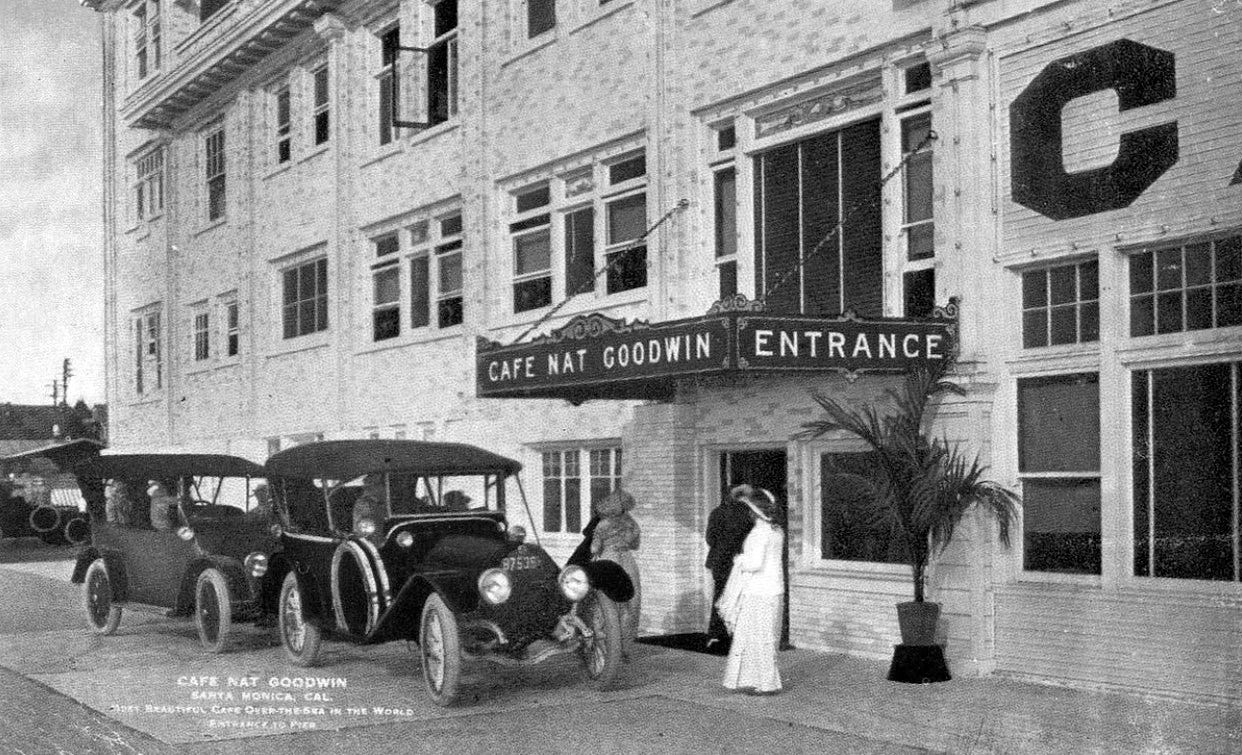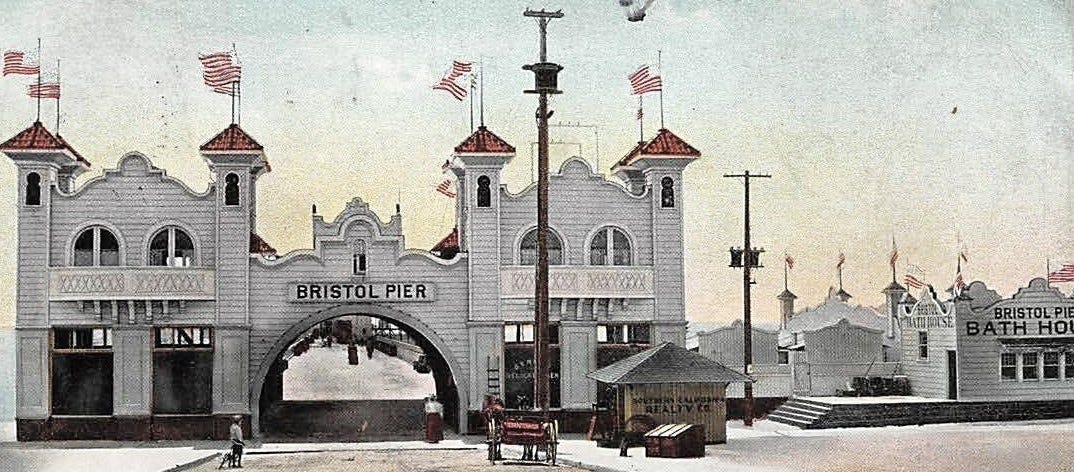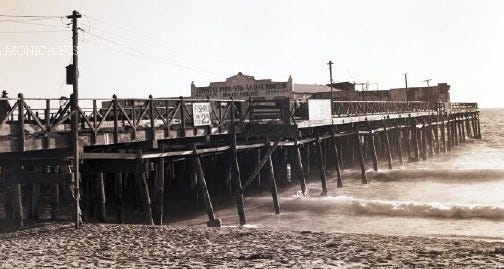Café Nat Goodwin is gone. Long gone. It was on Ocean Park’s smallest pleasure pier (known consecutively as the Hollister Pier, the White Star Pier, the Bristol Pier, the Nat Goodwin Pier and finally the Crystal Pier) located at the foot Hollister Avenue from 1905 to 1949.
The private White Star amusement pier (designed by Alfred Rosenheim for the Hollister Avenue Pier Company) is completed in 1905. A band is installed and a number of "amusements" provided. The White Star Pier opens July 4, 1905 - the same day as Abbot Kinney’s Venice of America. There are many rival attractions - and the White Star pier loses money during its first season - and is sold in 1906.
The re-constructed pier re-opens in 1907 - with the addition of a dining hall, a bandstand, and an aquarium. The bath houses are removed from the pier and placed on the shore. In 1908, the pier is renamed the Bristol Pier - after the Bristol Café (operated by restaurateurs William Schneider & Jacob Feiber). In 1912, the café is moved shoreward to be only 300 feet from the boardwalk.
In 1913, vaudevillian comic Nat Goodwin1 takes over the Bristol Café (with his wife Margaret Moreland running the kitchen) and renames it the Café Nat Goodwin. The Café Nat Goodwin was one of the swankiest on the beach and includes a cabaret, a ballroom and a roof garden. In 1916, Goodwin sells his café to the ubiquitous Baron Long,2 and his house to Charles Modini Wood.
In 1919, a fire destroys the Venice Pier. In 1924, the Ocean Park Piers burn.
In 1923, a business group obtains rights to the Crystal Pier and the beach (Crystal Beach) between Hollister and Strand. In 1926, plans are announced for new structures on the Crystal Pier - memberships in the “Crystal Pier Club” are for sale and demolition of structures on the pier begins. However, the project is never completed - likely due to the onset of the Great Depression.
With the 1932 Olympics visitors in mind, a large solarium is built and the “Crystal Pier Sun and Surf Club” is formed in 1931. After an attempt to sell the pier for 25 cents on the dollar is made in 1936, the pier is abandoned.
In 1948, the city condemns the abandoned structure as a health and safety hazard, and the Crystal Pier is removed in 1949.
Nathaniel Carl “Nat” Goodwin (1857 – 1919)
Born in Boston, Goodwin discovered at a young age his ability to mimic, and determined to go on the stage. He studied for the stage, and made his first appearance in 1873. But it was not until 1889, that Goodwin’s talent as a comedian of the “legitimate” type began to be recognized. From that time he appeared in a number of plays designed to display his dry humorous manner. In 1908, he retired from the stage to look after mining interests in Nevada. He acquired a hotel in San Francisco, New York City real estate, a California ranch, and a home in Santa Monica.

Goodwin was married five times. He married his 5th wife, the actress Margaret Moreland in 1912 (they were divorced in 1918). In 1913, he opened Café Nat Goodwin on the Bristol Pier. By 1916, Goodwin had to give up the house, the café and go back to work – which killed him. Goodwin played in a few silent films, appearing as Fagin in Oliver Twist (1912) and in four films in 1915 - 1916. He was touring “Why Marry?” when he mistakenly washed his right eye with chloroform and his eye had to be removed. He died from shock two weeks later in New York City at age 62 - survived by both of his parents. With the actor at the time of his death, was Georgina Gardner who was to have become his 6th wife. At the time of his death, he was deeply in debt.
Baron Long (1883 – 1962)
Baron (“Baron” was his given name) Long was born in Fort Wayne, Indiana. Long rose from a small-time bad boy to a major player in night clubs, hotels, and horse racing. Long was a major influence in hotel and night club design, and a close friend of film studio heads. Long owned two other seaside nightclub-restaurants, the Ship Café in Venice and the Sunset Inn in Santa Monica. He bought the U.S. Grant Hotel in San Diego in 1919; was a partner in the Agua Caliente hotel, casino, and racetrack resort in Tijuana from 1928; and capped his career in 1933, by taking over the Los Angeles Biltmore Hotel.












